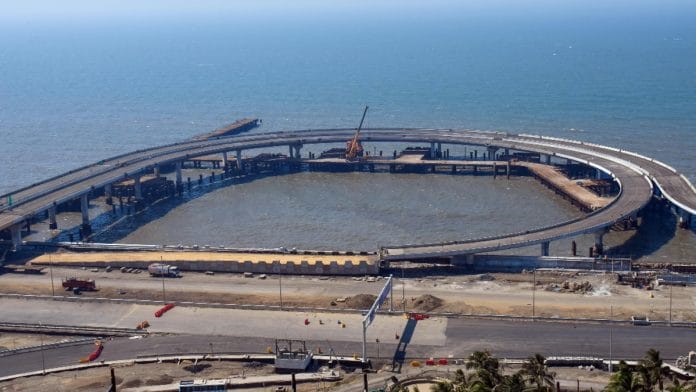The controversy surrounding Delhi University’s decision to name its new college after Vinayak Damodar Savarkar highlights the continuing relevance of historical figures in modern Indian politics. Over the past couple of weeks, heated arguments, party statements, and television debates have demonstrated that India—from North to South—continues to grapple with understanding figures in its recent past such as Savarkar, Manmohan Singh, Pranab Mukherjee, and Narayana Guru, not to mention its vast civilisational history.
It is natural, therefore, that the politics of naming remains complex, as political parties, organisations, and ordinary people compete to honour those they look up to or wish to remember. Yet, planners often drop the ball when it comes to naming key infrastructure—honouring these figures in letter but not necessarily in spirit.
Take Mumbai’s coastal road, for example, which is expected to be fully operational by 26 January. Its official name—Dharmveer Swarajya Rakshak Chhatrapati Sambhaji Maharaj Coastal Road—while respectful, contains three honorifics and a title, making it longer than ‘Chhatrapati Shivaji Maharaj International Airport’, which honours his father who founded the storied Maratha Empire. In practice, however, people typically refer to it simply as the ‘Mumbai coastal road’ or just the ‘coastal road’.
What’s in a name, one might ask, if the historical figure it commemorates is forgotten?
There are innumerable examples of such long, unwieldy—and ultimately unused—names adorning major infrastructure across parties, states, and linguistic regions. This begs the question: What is truly being achieved by naming key infrastructure in this fashion? Are we honouring historical giants meaningfully by ensuring their names are remembered and by kindling curiosity in current and future generations to learn about them? Or are we merely engaging in competitive respect-signalling that does little to generate a proper historical consciousness among Indians?
Indeed, it is possible to name infrastructure in a way that promotes historical remembrance. Popular examples in common usage like ‘Atal Setu’ or ‘JFK Airport’ show how key infrastructure should be named, ensuring that historical figures are actually remembered rather than reduced to political or ceremonial checkboxes.
Keep it simple
For a name to be widely adopted, the honorific, title, and reference to the historical figure should be kept short and simple—preferably no more than three words. ‘Veer Savarkar College’, Sardar Patel Marg (in Delhi), and Rajajinagar (in Bengaluru) strike a balance between using honorifics and ensuring conciseness, making them easy to use in everyday language. Alternatively, if the historical personality is well known, the eponym should be amenable to a simple acronym of three to four letters, as in the case of ‘JFK Airport’ or the ubiquitous MG Road found in many Indian cities.
Even when there is a desire to extensively honour a figure in the official name, it must include a concise version that rolls off the tongue. For instance, Mumbai’s trans-harbour bridge, officially named the ‘Atal Bihari Vajpayee Sewri-Nhava Sheva Atal Setu’, is undoubtedly too long a name for regular use. However, the inclusion of ‘Atal Setu’ at the end, highlighted in media releases, Prime Minister Narendra Modi’s inauguration speech, and social media posts, has ensured its widespread recognition. This approach not only honours Atal Bihari Vajpayee but also provides a practical name for commuters, as ‘Setu’ (meaning bridge) acts as a functional descriptor. Thus, it achieves the dual purpose of preserving historical remembrance and serving everyday utility.
Also read: Shivaji statue in Ladakh is part of an unfortunate trend. Indian Army must introspect
Avoid other unique descriptors
The official name for infrastructure should ideally avoid standalone descriptors that people might use instead of the intended name. This issue has bedevilled the ‘Mumbai Coastal Road’ and the ‘Rajiv Gandhi Sea Link’ (also known as the ‘Bandra-Worli Sea Link’ but generally referred to as simply the ‘Sea Link’). Since Mumbai currently has only one coastal road and one sea link, the public usually dispenses with the eponyms, as they add no practical informational value. One can only speculate whether names like ‘Chhatrapati Sambhaji Path’ or ‘Rajiv Setu’ would gain traction in common parlance—but their likelihood of adoption would certainly be higher.
Of course, this can sometimes be an insurmountable challenge, as in the case of airports. Since Indian cities do not yet have multi-airport systems, people naturally default to simpler names like ‘Delhi Airport’ or ‘Kolkata Airport’ instead of the eponyms in the official names. However, this trend will likely change as multi-airport systems gradually emerge in cities like Mumbai, Delhi, and Chennai. Politicians and planners must keep these principles in mind to ensure the eponyms stick with people when that happens.
Also read: How Nehru and Yogi Adityanath differed on naming cities — from Chandigarh to Prayagraj
Honour extensively and widely
Indian history is so complex and multi-layered that politicians and decision-makers across the country, irrespective of ideological leanings, should have no shortage of key historical figures to honour. Instead of repeatedly naming similar infrastructure after the same person—leading to confusion and prompting the public to come up with their own informal nomenclature—why not diversify the figures we commemorate? In Maharashtra, especially Mumbai, why don’t we see more prominent infrastructure named after great heroes of the Maratha Empire, such as Tanaji Malusare, Peshwas Bajirao and Madhavrao, and Kanhoji Angre? The same holds true for local heroes of the Indian Independence movement in every state.
If India wants to cultivate a genuine historical consciousness in current and future generations, it must approach the naming of infrastructure with great seriousness and keep the end-user always in mind. Without this, key historical figures will fade from public memory, only to be resurrected sporadically for electorally driven political one-upmanship. Given its rich and vibrant history, India can and should do better.
The author is a student at the University of Sydney, Sydney, New South Wales, Australia. Views are personal.
(Edited by Aamaan Alam Khan)






